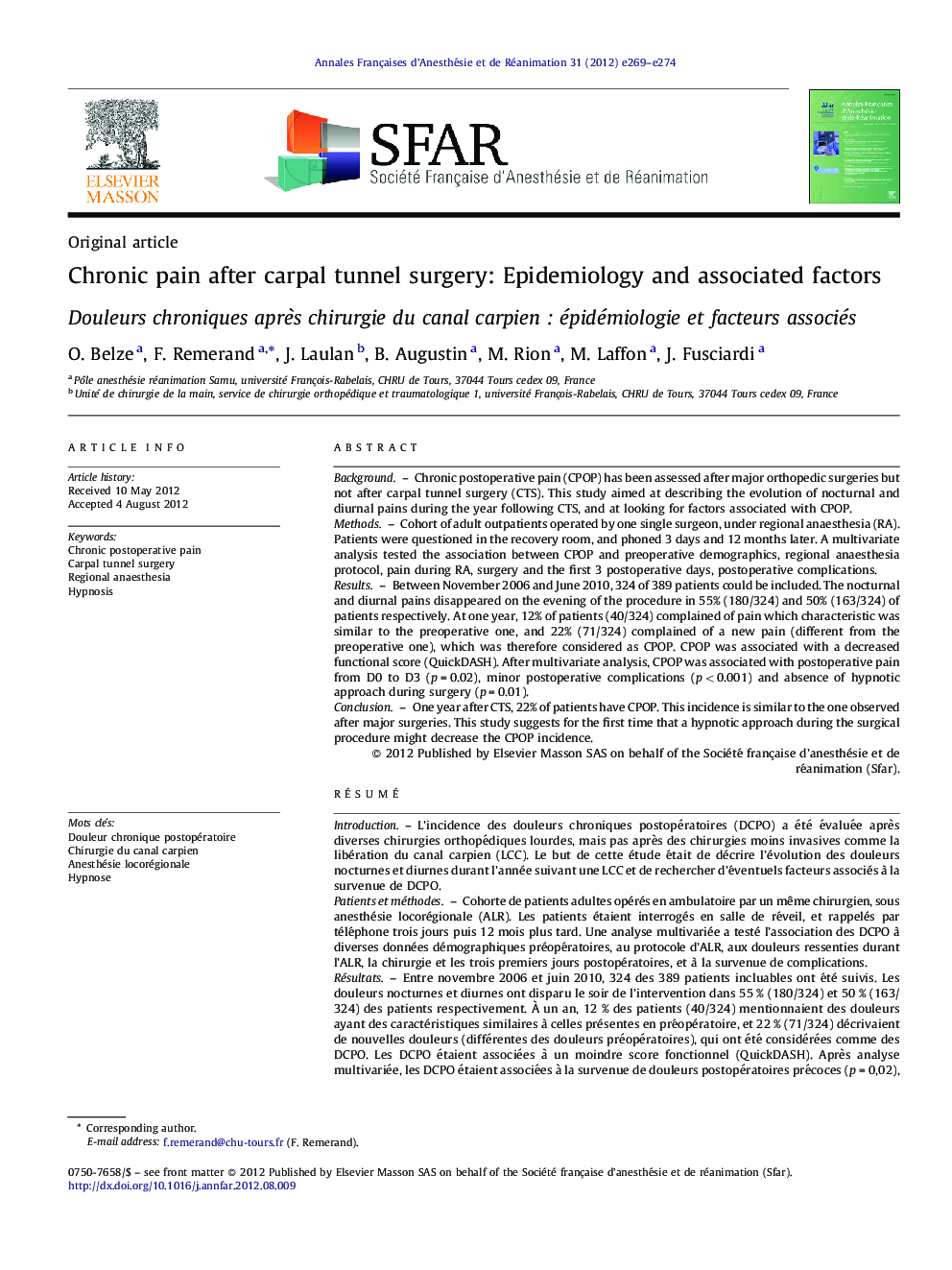| کد مقاله | کد نشریه | سال انتشار | مقاله انگلیسی | نسخه تمام متن |
|---|---|---|---|---|
| 2745746 | 1148847 | 2012 | 6 صفحه PDF | دانلود رایگان |

BackgroundChronic postoperative pain (CPOP) has been assessed after major orthopedic surgeries but not after carpal tunnel surgery (CTS). This study aimed at describing the evolution of nocturnal and diurnal pains during the year following CTS, and at looking for factors associated with CPOP.MethodsCohort of adult outpatients operated by one single surgeon, under regional anaesthesia (RA). Patients were questioned in the recovery room, and phoned 3 days and 12 months later. A multivariate analysis tested the association between CPOP and preoperative demographics, regional anaesthesia protocol, pain during RA, surgery and the first 3 postoperative days, postoperative complications.ResultsBetween November 2006 and June 2010, 324 of 389 patients could be included. The nocturnal and diurnal pains disappeared on the evening of the procedure in 55% (180/324) and 50% (163/324) of patients respectively. At one year, 12% of patients (40/324) complained of pain which characteristic was similar to the preoperative one, and 22% (71/324) complained of a new pain (different from the preoperative one), which was therefore considered as CPOP. CPOP was associated with a decreased functional score (QuickDASH). After multivariate analysis, CPOP was associated with postoperative pain from D0 to D3 (p = 0.02), minor postoperative complications (p < 0.001) and absence of hypnotic approach during surgery (p = 0.01).ConclusionOne year after CTS, 22% of patients have CPOP. This incidence is similar to the one observed after major surgeries. This study suggests for the first time that a hypnotic approach during the surgical procedure might decrease the CPOP incidence.
RésuméIntroductionL’incidence des douleurs chroniques postopératoires (DCPO) a été évaluée après diverses chirurgies orthopédiques lourdes, mais pas après des chirurgies moins invasives comme la libération du canal carpien (LCC). Le but de cette étude était de décrire l’évolution des douleurs nocturnes et diurnes durant l’année suivant une LCC et de rechercher d’éventuels facteurs associés à la survenue de DCPO.Patients et méthodesCohorte de patients adultes opérés en ambulatoire par un même chirurgien, sous anesthésie locorégionale (ALR). Les patients étaient interrogés en salle de réveil, et rappelés par téléphone trois jours puis 12 mois plus tard. Une analyse multivariée a testé l’association des DCPO à diverses données démographiques préopératoires, au protocole d’ALR, aux douleurs ressenties durant l’ALR, la chirurgie et les trois premiers jours postopératoires, et à la survenue de complications.RésultatsEntre novembre 2006 et juin 2010, 324 des 389 patients incluables ont été suivis. Les douleurs nocturnes et diurnes ont disparu le soir de l’intervention dans 55 % (180/324) et 50 % (163/324) des patients respectivement. À un an, 12 % des patients (40/324) mentionnaient des douleurs ayant des caractéristiques similaires à celles présentes en préopératoire, et 22 % (71/324) décrivaient de nouvelles douleurs (différentes des douleurs préopératoires), qui ont été considérées comme des DCPO. Les DCPO étaient associées à un moindre score fonctionnel (QuickDASH). Après analyse multivariée, les DCPO étaient associées à la survenue de douleurs postopératoires précoces (p = 0,02), de complications bénignes (p < 0,001), et à l’absence d’approche hypnotique durant l’intervention (p = 0,01).ConclusionUn an après LCC, 22 % des patients ont des DCPO. Cette incidence est similaire à celle observée après des chirurgies plus lourdes. Cette étude suggère pour la première fois qu’une approche hypnotique durant l’intervention pourrait limiter la survenue de DCPO.
Journal: Annales Françaises d'Anesthésie et de Réanimation - Volume 31, Issue 12, December 2012, Pages e269–e274